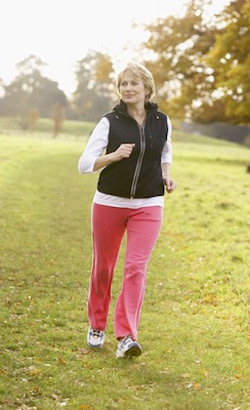Walking: a Super Food for Fitness

Twenty minutes of
walking
a day – or its equivalent – can cut the risk of many diseases and premature
death by almost a third.
American College of Sports Medicine’s (ACSM 2014) recommends 30–60 minutes a
day of moderate-intensity
exercise at least 5 days a week, or 20–60 minutes a day of vigorous-intensity
exercise at least 3 days a week—or a combination of the two.
In the words of scientist Katy Bowman, walking is a biological imperative
like eating “It is a
super
food. It’s the defining movement of a human. It’s a lot easier to get
movement than it is to get exercise.”
A recent survey found that a third of people can barely manage to
walk for 30 minutes over seven days, even when trips to the shops, work
or school are considered.
|
Defining Moderate Intensity
Scientifically,
walking at an intensity of 3–6 METs (metabolic equivalent of task is a
physiological measure expressing the energy cost of physical activities) is
considered moderate-intensity exercise.
Counting steps is another practical way to measure intensity. Marshall et al.
(2009) determined that
walking
at approximately 100 steps per minute is moderate-intensity exercise. At 100
steps per minute, a walker can meet current recommendations for
moderate-intensity physical activity by walking at least 3,000 steps in 30
minutes at least 5 days a week.
Group Walking: Find a Partner
According to research led by Sarah Hanson and Prof Andy Jones of UEA’s
Norwich Medical School., risk of stroke,
coronary heart disease,
depression
and other life-threatening conditions can be reduced through regular outdoor
walking in groups.
Join a walking group, today to boost your overall health. The benefits
are wide ranging – and they go above and beyond making people more physically
active. What’s more, people find it relatively easy to stick with this type of
exercise regime.
Why Walk?
Research Findings show:
-
People who joined walking groups registered statistically significant falls in
average blood pressure, resting
heart rate,
body fat,
weight,
and total cholesterol.
-
Walkers also experienced improvements in lung power, overall physical
functioning, and general
fitness,
and they were less depressed than before they started walking regularly.
-
Evidence was less clear-cut for reductions in other risk factors for ill
health, such as waist circumference, fasting blood glucose and blood fats.
-
Three-quarters of all participants stuck with the group, and there were few
side effects, apart from a handful of falls on roots or wet ground, and minor
injuries such as calf strain.
One way to promote and sustain walking is through the provision of outdoor
health walk groups, schemes which typically organize short walks of under an
hour in the natural environment.

Tips for Effective Walking
-
Maintain good posture throughout
-
Push off with your toes.
-
As you walk, take deep, rhythmic breaths, to get the maximum amount of
oxygen through your system.
-
If you want to firm up the upper body, try a pair of wrist weights to
really pump those arm muscles.
Ref:
Dated 19 February 2015
Related Links
|









